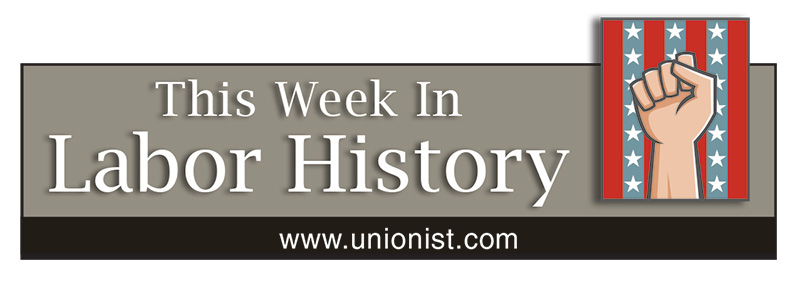This week in labor history: September 7-13

SEPTEMBER 7
1916 – Federal employees win the right to receive Workers’ Compensation insurance coverage.
SEPTEMBER 8
1909 – Employers give in to the demands of thousands of Wobblies-led striking railroad car production workers in McKees Rocks, Pa., agree to improved working conditions, 15 percent hike in wages and elimination of a “pool system” that gave foremen control over each worker’s pay.
1942 – Workers give up their Labor Day weekend holidays to keep the munitions factories working to aid in the war effort. Most Labor Day parades are cancelled in respect for members of the Armed Services.
1942 – Five Liberty ships named after Labor leaders are launched this Labor Day. They were built by union labor in Kaiser and Bethlehem shipyards on both coasts. The ships were named after the late leaders Andrew Fruseth of the Sailors Union of the Pacific and the International Seamen’s Union; Peter J. McGuire of the Carpenters; James Duncan of the Granite Cutters; John W. Brown of the Marine and Shipbuilding Workers of America; and John Mitchell of the Mine Workers.
1965 – United Farm Workers union begins historic national grape boycott and strike, Delano, Calif.
1997 – Some 2,600 Bay Area Rapid Transit (BART) workers begin what is to be a successful six-day strike for higher pay and against a two-tier wage system.
SEPTEMBER 9
1890 – In convention at Topeka, Kan., delegates create the Brotherhood of Railway Carmen of America. The men who repaired the nation’s rail cars were paid 10 or 15 cents an hour, working 12 hours a day, often seven days a week.
1919 – More than a thousand Boston police officers strike after 19 union leaders are fired for organizing activities. Massachusetts Gov. Calvin Coolidge announced that none of the strikers would be rehired, mobilized the state police, and recruited an entirely new police force from among unemployed veterans of the Great War (World War I).
1924 – Sixteen striking Filipino sugar workers on the Hawaiian island of Kauai are killed by police; four police died as well. Many of the surviving strikers were jailed, then deported.
1973 – United Auto Workers President Leonard Woodcock is named in Pres. Richard Nixon’s “Enemy’s List,” a White House compilation of Americans Nixon regarded as major political opponents. Another dozen union presidents were added later. The existence of the list was revealed during Senate Watergate Committee hearings.
SEPTEMBER 10
1897 – In Pennsylvania, Polish, Lithuanian and Slovak miners are gunned down by the Lattimer Mine’s sheriff deputies — 19 were killed, and more than 50 wounded — during a peaceful march from Hazelton to Lattimer. Some 3,000 were marching for collective bargaining and civil liberty. The shooters were tried for murder, but the jury failed to convict.
SEPTEMBER 11
1897 – Some 75,000 coal miners in Pennsylvania, Ohio and West Virginia end a 10-week strike after winning an eight-hour day, semi-monthly pay, and the abolition of overpriced company-owned stores, where they had been forced to shop. (Remember the song, “Sixteen Tons,” by coal miner’s son Merle Travis, in which there’s this line: “I owe my soul to the company store.”)
2001 – More than 3,000 people die when suicide hijackers crashed planes into the World Trade Center towers, the Pentagon and a Pennsylvania field. Among the dead in New York were 634 union members, the majority of them New York City fire fighters and police on the scene when the towers fell.
2009 – Crystal Lee Sutton, the real-life Norma Rae of the movies, dies at age 68. She worked at a J.P. Stevens textile plant in Roanoke Rapids, N.C., when low pay and poor working conditions led her to become a union activist.
SEPTEMBER 12
1918 – Eugene V. Debs, Labor leader and socialist, sentenced to 10 years for opposing World War I. While in jail Debs received one million votes for president.
1932 – Jobless workers march on grocery stores and seize food in Toledo, Ohio.
1934 – National Guardsmen fire on “sullen and rebellious” strikers at the Woonsocket (Rhode Island) Rayon plant, killing one and injuring three others. A correspondent said the crowd of about 2,000 “went completely wild with rage.” As word spread, 6,000 more workers arrived at the scene and the city was put under military rule. The governor declared that “there is a Communist uprising and not a textile strike” in the state.
1935 – United Rubber Workers forms in Akron, Ohio.
1940 – A total of 49 people are killed, 200 injured, in explosion at the Hercules Powder Company plant in Kenvil, N.J.
1998 – New York City’s Union Square, the site of the first Labor Day in 1882, is officially named a national historic landmark. The square has long been a focal point for working class protest and political expression.
SEPTEMBER 13
1926 – The Post Office Department orders 25,000 railway mail clerks to shoot to kill any bandits attempting to rob the mail.
1971 – Eleven AFSCME-represented prison employees and 33 inmates die in four days of rioting at New York State’s Attica Prison and the retaking of the prison. The riot caused the nation to take a closer look at prison conditions, for inmates and their guards alike.
(Compiled by David Prosten, founder Union Communication Services)

